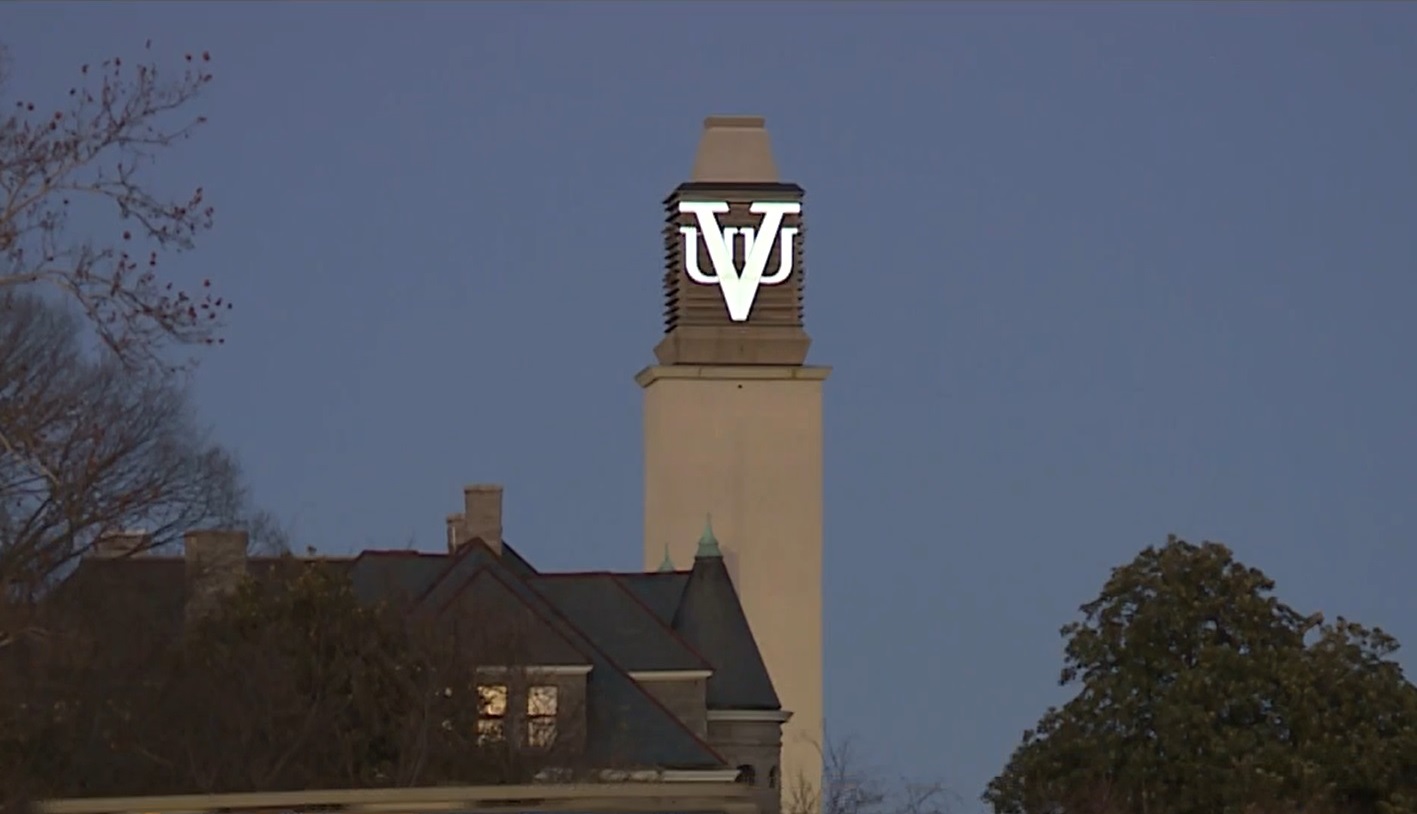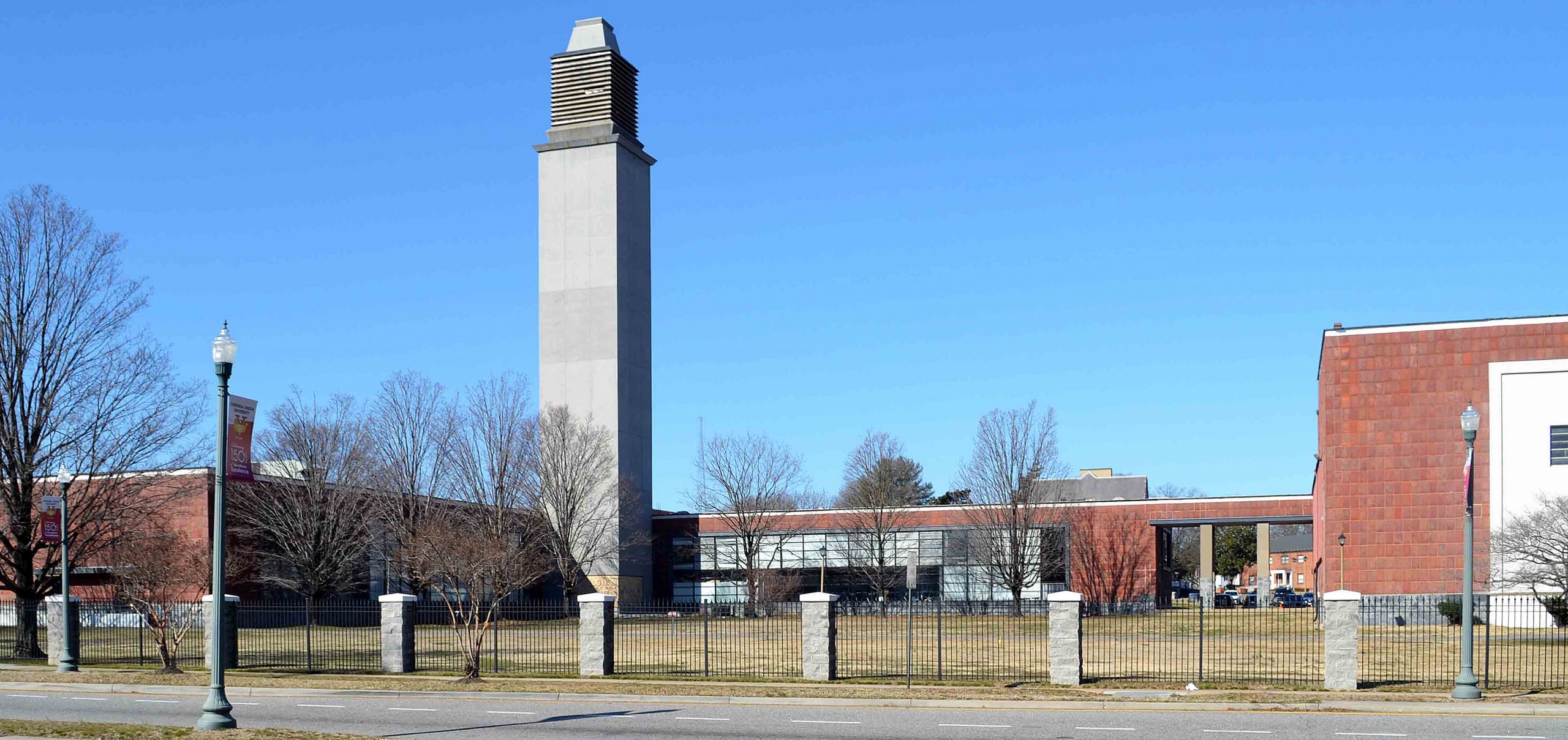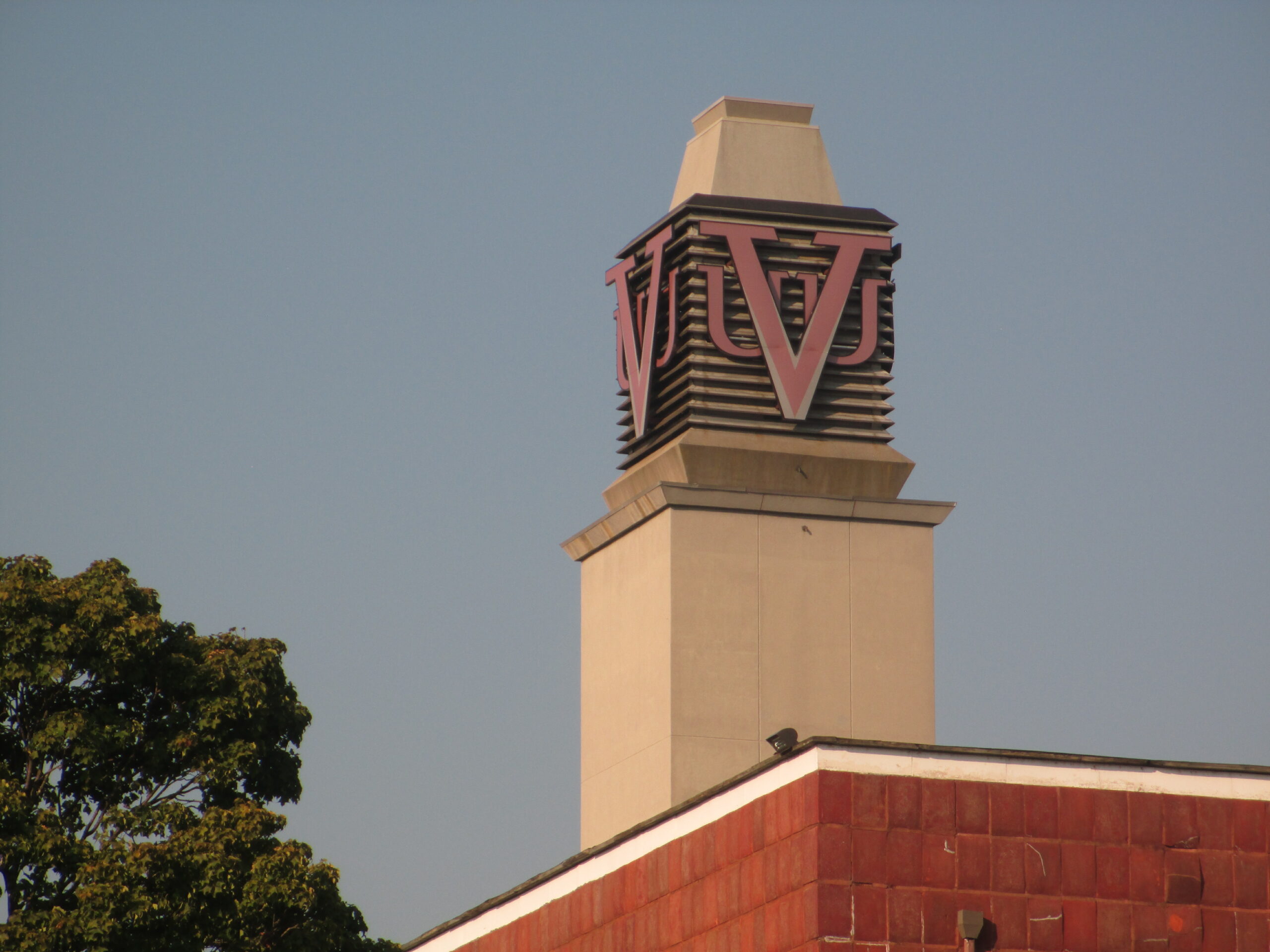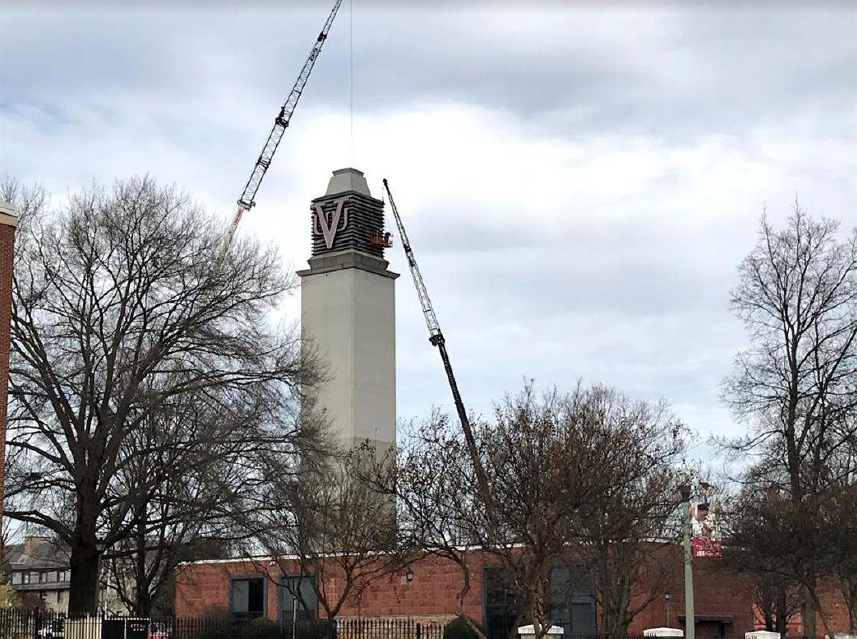
An illuminated logo sign on Virginia Union University’s Belgian Building tower. (Screenshot courtesy of WTVR)
When Virginia Union University placed illuminated logo signs at the top of its campus bell tower a year and a half ago, it did so without required local and state approvals — making the “VUU” signs technically illegal.
Now, as the university seeks a city permit for the signs, an agreement with the state also is in the works that would allow the signage to remain in place.
The state Board of Historic Resources, which is part of the Virginia Department of Historic Resources (DHR) and holds a preservation easement over the 1930s-era tower and adjoining Belgian Building, is finalizing the agreement that would authorize the signs but also require VUU to take certain steps to mitigate their placement in violation of the easement.
Those steps would likely include regular structural monitoring to ensure that the signs are not damaging the tower, as well as other efforts aimed at preserving the structures and informing the public about their history, such as potential highway markers and a preservation plan for the historically recognized campus.
Julie Langan, director of DHR, said the board has reached a verbal agreement with VUU but is in the process of drafting a formal document. She said the process would not be able to be completed in time for the Richmond Planning Commission’s Sept. 20 meeting, when VUU’s request for a special-use permit was slated to be reviewed.
“We’re finalizing those negotiations and we’re going to memorialize all that in a written agreement, but we’re not quite there yet,” Langan said.
“The Board of Historic Resources has approved a mitigation plan that would allow for the signs to remain, and that was with considerable discussion and a lot of concern over a period of several months,” she said. “The addition of that signage is very clearly a violation of the preservation easement, so we’ve been looking at ways to mitigate that violation.”
VUU, which established the easement with DHR in 2010, submitted its permit request to the city last December, nearly a year after DHR and city officials notified it of the violations. The Planning Commission had been scheduled to consider the request this May but deferred a vote in order to hear from DHR on the issue.
DHR maintains that the signs are not compatible with the historic character of the structures, and that the violation undermines the purpose of the Virginia Historic Preservation Easement Program, which is supposed to provide long-term legal protection of historic landmarks that are privately owned. The 2010 easement was a requirement related to federal grant monies awarded to VUU, according to DHR.
International in origin and style
Originally a pavilion designed by a noted Belgian architect for Belgium’s entry in the 1939 New York World’s Fair, the tower and Belgian Building was awarded to VUU over other competing U.S. universities when Belgium offered it due to the Nazi invasion of the country during World War II. A fundraising effort led by VUU produced the $500,000 needed to relocate the complex.

The Belgian Building and tower, shown before the signs were erected, were originally a pavilion designed as Belgium’s entry in the 1939 New York World’s Fair. (Courtesy of DHR)
The structures’ architecture is considered representative of the International Style, with minimal ornamentation and colors, modular forms and flat surfaces, and an emphasis on volumes, a city planning report states. The belfry section at the top of the tower is distinctive for its louvers, which the signage partially obscures.
The 165-foot tower was named after Robert Lee Vann, a VUU alum who established the Pittsburgh Courier newspaper and served as special assistant to the U.S. attorney general under President Franklin Roosevelt. The Courier in 1941 described the tower as “the largest memorial ever built for a Negro in America,” according to the permit application from VUU, a historically black university.
Adding to the Vann Memorial Tower’s significance to VUU are sculptures at its base and on the Belgian Building depicting scenes of Belgian Congo relief efforts, referencing Belgium’s rule of the former African colony and its eventual independence.
In its application to the city, VUU quotes an African-American news reporter who covered the tower’s cornerstone placement and described the complex as “the gift of a colonial empire to a Negro university, the gift of a Catholic country to a Baptist school, the symbol of human understanding and goodwill and the negation of racial prejudice of hatred and of violence.”
“Powered by this notable history,” the application continues, “and intensified by multiple layers of symbolic progressive change, the Belgian Pavilion Vann Tower is the premiere location to adorn at its top the illuminate ‘VUU’ logo as a symbol of change and beacon of light.”
In 2019, VUU received a $500,000 grant from the National Parks Service, through its African American Civil Rights Grant Program, to restore and renovate the Belgian Building. That project would involve DHR in terms of ensuring compliance with the preservation easement.
Removal requested
In January 2020, DHR sent a letter to VUU President Hakim Lucas informing him of the easement violation and requiring removal of the signs within 30 days, according to documents obtained through a Freedom of Information Act request.
Twenty months later, the signs remain in place.
“The university refuses to remove the signs,” Langan said last week. “We asked them to remove the signs and they refused, so then we looked at ways to manage the situation.”
A second letter sent in October suggested projected illuminations onto the tower as a permissible alternative. Spotlights illuminating the tower structure at night were added by VUU in 2016.
Langan said regular monitoring of the tower would be necessary if the existing signs are to remain in place. The signs were manufactured by Talley Sign Co., also based in Northside.
“One consideration is: how do we ensure that these signs aren’t doing damage to the tower? We’ve been discussing regular monitoring by a structural engineer so that we can be sure that no damage is being done,” Langan said.
In its application to the city, VUU maintains that the signs are not damaging the tower and that their size is justified by their elevated position and their “purpose of being a beacon for a bright, limitless future and recognition of the rich African-American history of the campus, community, City and State.”
“This project for the VUU logo to remain affixed to the Belgian Vann Tower has critical impact to VUU and to people of color feeling a sense of disillusionment and lack of acceptance,” the application states. “The VUU signage on the tower will provide a lasting bright-(shining) symbol of justice, hope, and equality.”
‘Symbol of change’
In a presentation to the Planning Commission prepared for the May meeting, VUU contended that the logos’ appearance on the tower is consistent with modern architectural styles, and that their addition is a “symbol of change” along the lines of the Robert E. Lee Monument’s transformation over the past year from Confederate memorial to social justice symbol.
VUU’s permit request has the support of the neighboring Edgehill-Chamberlayne Court Civic Association, which submitted a letter to the city in favor of the permit.
Attempts to reach VUU President Lucas or other university officials for comment for this story were unsuccessful. A request submitted Thursday to a VUU spokeswoman was not fulfilled by the weekend.
Local attorney Dale Mullen with Whiteford Taylor Preston is representing VUU in its application to the city and negotiations with DHR. He did not return a call seeking comment.
In its report to the Planning Commission, city planning staff recommends denying VUU’s permit request because the 17-by-17-foot signs exceed size limits allowed under the university’s institutional zoning. Staff also notes that the Commission of Architectural Review (CAR), in reviewing a request for a certificate of appropriateness, determined the signs violate the city’s historic preservation guidelines.
VUU requested the certificate after it was notified of the city violation. VUU appealed CAR’s denial, but its appeal request was received a day after the deadline to do so, the staff report states.
Without the formal DHR agreement in hand at Monday’s meeting, the commission is likely to defer the request again for at least another month, said Richard Saunders, the city planner assigned to the case. With the agreement, Saunders said, VUU could again pursue CAR approval instead of the special-use route — a scenario he said the city would prefer.
In its application, VUU said other illuminated signs on its campus have been allowed through special-use permits. Saunders said CAR approval is preferred in this case because these signs are located in the Belgian Building Old and Historic District, a city designation specific to the structures that requires CAR approval of any building modifications.
The structures also are listed on state and national historic registers, as is the larger VUU campus. VUU was founded in 1865 as one of the first black higher-education institutions in the country.

An illuminated logo sign on Virginia Union University’s Belgian Building tower. (Screenshot courtesy of WTVR)
When Virginia Union University placed illuminated logo signs at the top of its campus bell tower a year and a half ago, it did so without required local and state approvals — making the “VUU” signs technically illegal.
Now, as the university seeks a city permit for the signs, an agreement with the state also is in the works that would allow the signage to remain in place.
The state Board of Historic Resources, which is part of the Virginia Department of Historic Resources (DHR) and holds a preservation easement over the 1930s-era tower and adjoining Belgian Building, is finalizing the agreement that would authorize the signs but also require VUU to take certain steps to mitigate their placement in violation of the easement.
Those steps would likely include regular structural monitoring to ensure that the signs are not damaging the tower, as well as other efforts aimed at preserving the structures and informing the public about their history, such as potential highway markers and a preservation plan for the historically recognized campus.
Julie Langan, director of DHR, said the board has reached a verbal agreement with VUU but is in the process of drafting a formal document. She said the process would not be able to be completed in time for the Richmond Planning Commission’s Sept. 20 meeting, when VUU’s request for a special-use permit was slated to be reviewed.
“We’re finalizing those negotiations and we’re going to memorialize all that in a written agreement, but we’re not quite there yet,” Langan said.
“The Board of Historic Resources has approved a mitigation plan that would allow for the signs to remain, and that was with considerable discussion and a lot of concern over a period of several months,” she said. “The addition of that signage is very clearly a violation of the preservation easement, so we’ve been looking at ways to mitigate that violation.”
VUU, which established the easement with DHR in 2010, submitted its permit request to the city last December, nearly a year after DHR and city officials notified it of the violations. The Planning Commission had been scheduled to consider the request this May but deferred a vote in order to hear from DHR on the issue.
DHR maintains that the signs are not compatible with the historic character of the structures, and that the violation undermines the purpose of the Virginia Historic Preservation Easement Program, which is supposed to provide long-term legal protection of historic landmarks that are privately owned. The 2010 easement was a requirement related to federal grant monies awarded to VUU, according to DHR.
International in origin and style
Originally a pavilion designed by a noted Belgian architect for Belgium’s entry in the 1939 New York World’s Fair, the tower and Belgian Building was awarded to VUU over other competing U.S. universities when Belgium offered it due to the Nazi invasion of the country during World War II. A fundraising effort led by VUU produced the $500,000 needed to relocate the complex.

The Belgian Building and tower, shown before the signs were erected, were originally a pavilion designed as Belgium’s entry in the 1939 New York World’s Fair. (Courtesy of DHR)
The structures’ architecture is considered representative of the International Style, with minimal ornamentation and colors, modular forms and flat surfaces, and an emphasis on volumes, a city planning report states. The belfry section at the top of the tower is distinctive for its louvers, which the signage partially obscures.
The 165-foot tower was named after Robert Lee Vann, a VUU alum who established the Pittsburgh Courier newspaper and served as special assistant to the U.S. attorney general under President Franklin Roosevelt. The Courier in 1941 described the tower as “the largest memorial ever built for a Negro in America,” according to the permit application from VUU, a historically black university.
Adding to the Vann Memorial Tower’s significance to VUU are sculptures at its base and on the Belgian Building depicting scenes of Belgian Congo relief efforts, referencing Belgium’s rule of the former African colony and its eventual independence.
In its application to the city, VUU quotes an African-American news reporter who covered the tower’s cornerstone placement and described the complex as “the gift of a colonial empire to a Negro university, the gift of a Catholic country to a Baptist school, the symbol of human understanding and goodwill and the negation of racial prejudice of hatred and of violence.”
“Powered by this notable history,” the application continues, “and intensified by multiple layers of symbolic progressive change, the Belgian Pavilion Vann Tower is the premiere location to adorn at its top the illuminate ‘VUU’ logo as a symbol of change and beacon of light.”
In 2019, VUU received a $500,000 grant from the National Parks Service, through its African American Civil Rights Grant Program, to restore and renovate the Belgian Building. That project would involve DHR in terms of ensuring compliance with the preservation easement.
Removal requested
In January 2020, DHR sent a letter to VUU President Hakim Lucas informing him of the easement violation and requiring removal of the signs within 30 days, according to documents obtained through a Freedom of Information Act request.
Twenty months later, the signs remain in place.
“The university refuses to remove the signs,” Langan said last week. “We asked them to remove the signs and they refused, so then we looked at ways to manage the situation.”
A second letter sent in October suggested projected illuminations onto the tower as a permissible alternative. Spotlights illuminating the tower structure at night were added by VUU in 2016.
Langan said regular monitoring of the tower would be necessary if the existing signs are to remain in place. The signs were manufactured by Talley Sign Co., also based in Northside.
“One consideration is: how do we ensure that these signs aren’t doing damage to the tower? We’ve been discussing regular monitoring by a structural engineer so that we can be sure that no damage is being done,” Langan said.
In its application to the city, VUU maintains that the signs are not damaging the tower and that their size is justified by their elevated position and their “purpose of being a beacon for a bright, limitless future and recognition of the rich African-American history of the campus, community, City and State.”
“This project for the VUU logo to remain affixed to the Belgian Vann Tower has critical impact to VUU and to people of color feeling a sense of disillusionment and lack of acceptance,” the application states. “The VUU signage on the tower will provide a lasting bright-(shining) symbol of justice, hope, and equality.”
‘Symbol of change’
In a presentation to the Planning Commission prepared for the May meeting, VUU contended that the logos’ appearance on the tower is consistent with modern architectural styles, and that their addition is a “symbol of change” along the lines of the Robert E. Lee Monument’s transformation over the past year from Confederate memorial to social justice symbol.
VUU’s permit request has the support of the neighboring Edgehill-Chamberlayne Court Civic Association, which submitted a letter to the city in favor of the permit.
Attempts to reach VUU President Lucas or other university officials for comment for this story were unsuccessful. A request submitted Thursday to a VUU spokeswoman was not fulfilled by the weekend.
Local attorney Dale Mullen with Whiteford Taylor Preston is representing VUU in its application to the city and negotiations with DHR. He did not return a call seeking comment.
In its report to the Planning Commission, city planning staff recommends denying VUU’s permit request because the 17-by-17-foot signs exceed size limits allowed under the university’s institutional zoning. Staff also notes that the Commission of Architectural Review (CAR), in reviewing a request for a certificate of appropriateness, determined the signs violate the city’s historic preservation guidelines.
VUU requested the certificate after it was notified of the city violation. VUU appealed CAR’s denial, but its appeal request was received a day after the deadline to do so, the staff report states.
Without the formal DHR agreement in hand at Monday’s meeting, the commission is likely to defer the request again for at least another month, said Richard Saunders, the city planner assigned to the case. With the agreement, Saunders said, VUU could again pursue CAR approval instead of the special-use route — a scenario he said the city would prefer.
In its application, VUU said other illuminated signs on its campus have been allowed through special-use permits. Saunders said CAR approval is preferred in this case because these signs are located in the Belgian Building Old and Historic District, a city designation specific to the structures that requires CAR approval of any building modifications.
The structures also are listed on state and national historic registers, as is the larger VUU campus. VUU was founded in 1865 as one of the first black higher-education institutions in the country.



The Tower, so noble a structure, has now entered into the 2020-2021 racial politic. The University, through its actions, thinks they can just do whatever they want in the name of racial justice. Oddly, racial justice was already there, in the form of an 80 year old gift to blacks.
It’s a shame that Virginia Union has to jump through all of these hoops for a single illuminated sign, that doesn’t negatively affect anyone, including the surrounding community, which doesn’t object to the sign.
WIsh it were red neon!
… confirming that age-old saying: “It is better to ask for forgiveness than to ask for permission.”
If VUU wants a logo on their tower, then I see no reason to deny it. It goes against the rules, but I don’t see a negative impact to justify all of the commotion. Our planning commission has enough to focus on with getting new projects moving so we can increase the tax base faster.
Shame on DHR for prolonging the illumination of VUU logo on the bell tower. How convenient to miss the Sept 20 meeting to resolve this issue. VUU deserves to have their logo illuminated on the campus because for decades no one could tell you where the University was located in Richmond. VUU has been a hidden treasure of Richmond, Virginia. The bell tower was the only landmark visible while driving along the interstate. I am appalled that there is pushback for illuminating the logo. This has nothing to do with politics, it’s simply allowing the University to brand their institution… Read more »
Did the other universities mentioned use such historic buildings for their brand advertising? Should we look for similar iconic structures at other campuses in Ettrick, Harrisonburg, Charlottesville, Norfolk and Lexington and Blacksburg to propose similar lighted branding? I hope not.
If it’s necessary to see if other universities followed said precedent for illuminating historical structures (over the years) and to ensure they followed the same protocol for getting permission, then why not look at other universities?
“Saunders said CAR approval is preferred in this case because these signs are located in the Belgian Building Old and Historic District, a city designation specific to the structures that requires CAR approval of any building modifications.”
lol good luck if it goes to CAR. The CAR has regular meltdowns over things like vinyl windows.